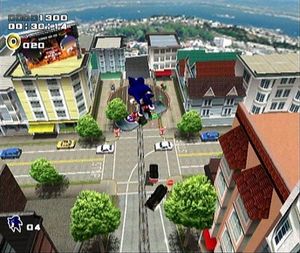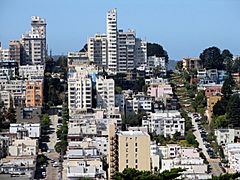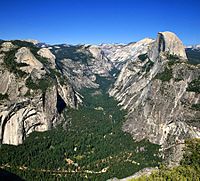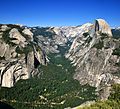Sonic Adventure 2 facts for kids
Quick facts for kids Sonic Adventure 2 |
|
|---|---|
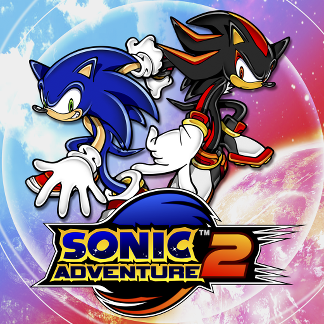 |
|
| Developer(s) | Sonic Team USA |
| Publisher(s) | Sega |
| Director(s) | Takashi Iizuka |
| Producer(s) | Yuji Naka |
| Designer(s) |
|
| Programmer(s) |
|
| Artist(s) |
|
| Writer(s) | Shiro Maekawa |
| Composer(s) |
|
| Series | Sonic the Hedgehog |
| Platform(s) | |
| Release date(s) | Dreamcast
GameCube
|
| Genre(s) | Platformer, action-adventure |
| Mode(s) | Single-player, multiplayer |
Sonic Adventure 2 is a fun platforming game made by Sonic Team USA and released by Sega. It was the last Sonic the Hedgehog game for the Dreamcast console. This happened after Sega stopped making its own game consoles.
The game has two main stories: one about heroes and one about villains. In the Hero story, Sonic, Tails, and Knuckles the Echidna try to save the world. In the Dark story, Shadow the Hedgehog, Doctor Eggman, and Rouge the Bat try to take over the world. Each story has three different ways to play. Sonic and Shadow have fast levels where you run and jump. Tails and Eggman fly in robots and shoot enemies. Knuckles and Rouge explore levels to find hidden treasures.
Making Sonic Adventure 2 took about 18 months. It was made to celebrate the Sonic series' tenth birthday. The game was designed to be faster and have more action than the first Sonic Adventure game. The creators also added more to the Chao creatures and other characters you can play as. Some of the places in the game were inspired by real places like San Francisco in the USA.
Sonic Adventure 2 got good reviews for its different ways to play, cool graphics, and music. Some people didn't like the camera or the voice acting. The game became very popular. An improved version, Sonic Adventure 2: Battle, came out for the GameCube later in 2001 and 2002. This version had better graphics and more ways to play with friends. Both the Dreamcast and GameCube versions sold over 2 million copies around the world. In 2012, Sonic Adventure 2 was also released for PlayStation 3, Xbox 360, and Windows computers.
Contents
How to Play Sonic Adventure 2
Sonic Adventure 2 is a 3D platform game with two main adventures: Hero and Dark. In the Hero adventure, you play as Sonic, Tails, and Knuckles. They are trying to save the world. In the Dark adventure, you play as Shadow the Hedgehog, Doctor Eggman, and Rouge the Bat. They are trying to take over the world.
Each adventure switches between the three characters. This lets you see different parts of the story. The levels have many themes, like cities, jungles, desert pyramids, and even outer space. Sometimes, you'll fight a boss at the end of a level. The two stories happen at the same time. If you finish both the Hero and Dark adventures, you unlock a final "Last Story." In this story, all six characters team up for one last big boss fight.
Character Play Styles
- Sonic and Shadow have fast-paced levels. You focus on running, jumping, and grinding on rails. They can use a "homing attack" to hit enemies.
- Tails and Eggman play in slower levels. They control big robots that can fly a little and shoot enemies. Their levels are more about shooting.
- Knuckles and Rouge have open levels where you explore and hunt for treasure. They need to find three pieces of the Master Emerald in each level. A radar helps them find the pieces. Knuckles and Rouge can glide, punch, kick, and climb walls. They can also dig into walls to find power-ups.
Health and Upgrades
In Sonic Adventure 2, you collect rings to stay safe. If you have rings and get hit by an enemy, you drop your rings. If you get hit without rings, you lose a life. Tails and Eggman have a health bar that rings help refill. If you run out of lives, it's game over.
You can also find permanent upgrades for your characters. These upgrades give them new abilities. For example, Sonic and Shadow can get an upgrade to dash across rings. Tails and Eggman can get hover jets to cross big gaps. Knuckles and Rouge can get an upgrade to dig into the ground to find hidden items.
Raising Chao
You can raise cute creatures called Chao in the game. They are like virtual pets. Chao have five skills: Swim, Fly, Run, Power, and Stamina. They also have a personality that can be Hero or Dark. You can make their skills better by giving them Chaos Drives or small animals found in the levels. Better skills help them compete in karate fights and racing minigames.
A Chao's personality changes based on which characters they like. For example, a Chao that likes Tails will become more heroic. Playing with your Chao makes them like you more. When a Chao becomes fully Hero or Dark, they stay that way. Chao eventually pass away, but if you take good care of them, they can be reborn.
Emblems and Secrets
There are 180 emblems to earn in Adventure 2. You get emblems for doing different tasks. Each level has five missions. You only need to finish the first mission to keep playing the story. Other missions include beating a harder version of a level or collecting 100 rings. You also earn emblems for raising Chao. If you collect all 180 emblems, you unlock a special 3D version of the Green Hill Zone level from the first Sonic the Hedgehog game.
Multiplayer Fun
The game has several two-player modes. You can race each other on foot in special levels. You can have shooting battles in robots. You can also hunt for Master Emerald pieces together or race in go-karts. Some characters are only playable in these multiplayer modes, like Tikal and Chaos from the first Sonic Adventure. Amy Rose and Metal Sonic can be played in foot races. Chao and Big the Cat (or a Dark Chao in Battle) can pilot robots in shooting levels.
Playable Characters
Here are the characters you can play as in Sonic Adventure 2:
- Sonic
- Tails
- Knuckles
- Shadow
- Dr. Eggman
- Rouge
- Amy Rose - Only in multiplayer
- Metal Sonic - Only in multiplayer
- Chao - Only in multiplayer
- Dark Chao - Only in multiplayer (in Battle version)
- Chaos 0 - Only in multiplayer
- Tikal - Only in multiplayer
- Big the Cat - Only in multiplayer (Dreamcast version)
- Eggrobo - Only in Kart Racing
- Omochao - Only in Kart Racing (Dreamcast version)
Story of Sonic Adventure 2
Doctor Eggman finds a secret weapon mentioned in his grandfather's diary. He goes into a high-security G.U.N. (Guardian Units of Nations) base. There, he uses a Chaos Emerald to wake up the weapon. This weapon is a black hedgehog named Shadow, who calls himself the "Ultimate Life Form." Shadow offers to help Eggman take over the world. He tells Eggman to meet him at an old space colony called ARK with more Chaos Emeralds.
Shadow goes to Central City and steals an Emerald. G.U.N. soldiers try to stop him. Shadow had promised his grandfather's granddaughter, Maria, that he would help mankind. But he thinks her promise means he should get revenge. Shadow fights through the soldiers and meets Sonic. After a quick fight, Shadow gets away. G.U.N. then captures Sonic, thinking he is Shadow.
Meanwhile, Knuckles meets Rouge and Eggman, who are both trying to steal the Master Emerald. Knuckles stops them by breaking the Emerald into many pieces. He then starts looking for the pieces to fix it. Rouge, who is secretly working for the government, goes to Eggman's base and the ARK. Shadow shows Eggman a powerful weapon called the Eclipse Cannon, also made by his grandfather. Shadow plans to power the cannon with Chaos Emeralds to take over the world. Rouge shows up and gives them a Chaos Emerald to gain their trust.
Tails and Amy sneak into G.U.N.'s island base and rescue Sonic. At the same time, Eggman, Shadow, and Rouge collect three more Emeralds on the island. Eggman then broadcasts a message to the world. He threatens to fire the Eclipse Cannon at Earth in 24 hours if his demands are not met. To show he's serious, he uses the cannon to destroy half of the Moon with their six Emeralds.
Sonic, Tails, Amy, and Knuckles use their own Chaos Emerald to find the others on the ARK. They sneak onto Eggman's shuttle just before it launches into space. Knuckles' Master Emerald pieces fall out during the trip. He leaves to collect them. He fights Rouge again, but when he saves her from falling into lava, she gives him her pieces. Knuckles then fixes the Master Emerald.
On the ARK, Tails reveals he made a fake Chaos Emerald to destroy the Eclipse Cannon. As Sonic is about to use it, Eggman tells him he has captured Tails and Amy. Sonic has to go back and rescue them. Sonic tries to trick Eggman with the fake Emerald, but Eggman sees through it. He then sends Sonic away in an escape pod with bombs. Tails, thinking Sonic is gone, fights and defeats Eggman. Sonic uses the power of the fake Emerald to use "Chaos Control" and escape. Shadow is sent to stop him.
No matter who wins the fight, Eggman secretly gets the last Emerald and activates the Eclipse Cannon. Suddenly, the whole colony starts falling towards Earth. A message from Gerald plays for everyone to hear. He programmed the ARK to crash into Earth if the Emeralds were used. This was his revenge for the government killing his friends, including Maria. Everyone, except Shadow, works together to get to the cannon's core. They plan to stop the ARK using the Master Emerald.
Amy asks Shadow for help. This makes him remember what Maria really wanted: for him to help mankind. Shadow catches up with Sonic and Knuckles in the core. They find the Biolizard, an early version of the Ultimate Life Form. Shadow fights it off, letting Knuckles turn off the Chaos Emeralds with the Master Emerald. The Biolizard uses Chaos Control to combine with the cannon. It becomes the Finalhazard and keeps the ARK on its path to crash into Earth.
Sonic and Shadow use the Emeralds to turn into their super forms. They defeat the Finalhazard and use Chaos Control to teleport the ARK back into a safe orbit. This uses up all of Shadow's energy. He falls towards Earth, happy that he kept his promise to Maria. People on Earth celebrate as the heroes return home. Sonic says goodbye to Shadow.
How Sonic Adventure 2 Was Made
Sonic Adventure 2 was made by Sonic Team USA, a part of Sonic Team, and published by Sega. Takashi Iizuka directed the game, and Yuji Naka produced it. They had both worked on Sonic games before. Making the game started after Sonic Adventure came out in America in 1999. It took about 18 months to finish.
The team wanted this game to have more action than the first Adventure game, which had more story. They made the game run very smoothly, at 60 frames per second. They also gave Sonic many different moves, not just focusing on speed. The levels were designed to make Sonic feel even faster. All six characters have about the same amount of playtime in the story.
The places in the game were inspired by real American locations. This included San Francisco, where Sonic Team had an office. They also visited Yosemite National Park for ideas. The team wanted the sequel to feel "more American." Because the team had more experience with the Dreamcast console, it was easier to make this game. They focused only on the most important parts.
The creators also made the Chao creatures more interesting. In Sonic Adventure, Chao were "neutral." But in the sequel, you can raise "Hero" or "Dark" Chao. This matches the good-vs-evil theme of the game. Chao can also interact with each other, making them feel more like real pets.
Sega showed off Sonic Adventure 2 with a trailer at E3 in 2000. They also promoted it as the last Sonic game for the Dreamcast. It was also made to celebrate the Sonic series' 10th anniversary.
Game Music
Jun Senoue was the main composer and sound director for Sonic Adventure 2, just like in the first Sonic Adventure. Other composers included Fumie Kumatani, Tomoya Ohtani, and Kenichi Tokoi. The music is mostly rock, with some hip hop and orchestra sounds. Each character has their own musical theme. Many singers returned for the game, and new ones joined too. The band Crush 40 (made up of Jun Senoue and Johnny Gioeli) sang the main theme song, "Live and Learn."
The team wanted the music to be more than just background noise. They wanted it to stand out and help tell the story. Jun Senoue felt some songs from the first game weren't as memorable. So, he and the other musicians worked hard to create songs that fit the game's speed and situations.
Several albums with the game's music were released. These included the Sonic Adventure 2 Multi-Dimensional Original Soundtrack and the Sonic Adventure 2 Vocals Collection: Cuts Unleashed. Later, for the Sonic series' 20th anniversary, a special soundtrack was released on iTunes.
Different Versions of the Game
Sonic Adventure 2: Battle
In 2001, Sega stopped making game consoles and started focusing on making games for other companies. So, Sonic Adventure 2 was released for the Nintendo GameCube as Sonic Adventure 2: Battle. This happened in December 2001.
Battle has more detailed graphics and new multiplayer options. It also adds new abilities, upgrades, and characters just for multiplayer. For example, Big the Cat is replaced by a Dark Chao in multiplayer mode. Battle also improved the Chao system. You could see your Chao's stats in the game. You could even transfer your Chao from Sonic Adventure 2 Battle to the Tiny Chao Garden in Sonic Advance games using a GameCube – Game Boy Advance link cable. This version also added Chao Karate.
Downloadable Versions
Sonic Adventure 2 was released again in HD for PlayStation Network and Xbox Live Arcade in October 2012. It also came out for Windows computers through Steam in November 2012. The extra content from Battle is available as downloadable content (DLC) for these versions. In 2017, the Xbox 360 version became playable on the Xbox One and later the Xbox Series X/S.
Game's Impact
Shadow and Rouge, who first appeared in Adventure 2, became important characters in the Sonic series. They both appeared as "Team Dark" in Sonic Heroes (2003), which was the next game after Adventure 2. Shadow even got his own game, Shadow the Hedgehog (2005). This game continued the story from Adventure 2 and had similar 3D platforming gameplay.
Parts of the stories from Sonic Adventure and Adventure 2 were used in the second season of the Sonic X anime show (2003–06).
Sonic Generations (2011), made for the series' twentieth anniversary, included levels and gameplay from many Sonic games. It had a remake of the City Escape stage from Sonic Adventure 2 in the console versions. The Radical Highway stage was remade for the Nintendo 3DS version. Shadow also appears as a boss fight, and the Biolizard boss is remade in the 3DS version.
Images for kids
See also
 In Spanish: Sonic Adventure 2 para niños
In Spanish: Sonic Adventure 2 para niños


